If a forest stand is inventoried and trees are shown to be growing in severe competition (growing too close to one another), forest stand improvement is one of the most common methods of dealing with this problem. If left alone, overstocked stands will eventually self-thin. However, there is no guarantee that the resulting forest would meet the owner’s objectives. To think of forest stand improvement in another way, it is like weeding a garden, except on a larger scale (and not all “weed trees” are removed in forest stand improvement).
Each year, hundreds of acres of forest stand improvement are conducted with the assistance of Gracie & Harrigan.
Forest stand improvement is most commonly thought of occurring in young stands of trees. However, research by the US Forest Service has shown that a variation of forest stand improvement known as “crop tree management” can improve forest health in older forests between 80 and 110 years in age.
Crop tree management begins with the identification of the superior trees within a forest stand. Once those superior trees are identified, the lesser trees that are directly competing with the superior trees are identified. Depending on the landowner’s objectives, many of the lesser trees are removed in order to provide more sunlight, and thus energy, for the superior trees.
We tend to use the terms forest stand improvement and crop tree management interchangeably.
The most common use for wood harvested by this method is for firewood.






